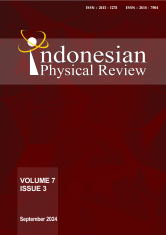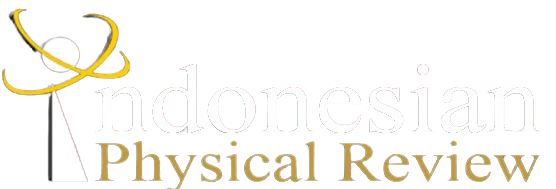MORLET’S WAVELET ANALYSIS ON EL NIÑO SOUTHERN OSCILLATION (ENSO) AND THE INDIAN OCEAN DIPOLE (IOD) FOR 84 YEARS: 1940-2023
DOI:
10.29303/ipr.v7i3.363Downloads
Abstract
As is known, the impact caused by El Niño Southern Oscillation (ENSO) and the Indian Ocean Dipole (IOD) can reach extreme levels, especially rainfall in Indonesia. So, updating information on events and cycles of these phenomena is essential. Using Sea Surface Temperature (SST) data spanning the previous 84 years (1940–2023) from ERA5, we examined Sea Surface Temperature Anomalies (SSTA), which serve as a predictive tool for ENSO and IOD events. Apart from that, in this research, SSTA variance analysis was also carried out using Wavelet. The analysis results show several Positive IOD-Like events (1943, 1944, 1977, 1996) and Negative IOD-Like (1985, 1992, 2016). Apart from that, the results of this research also show that El Niño in 2002/03 coincided with Negative IOD in 2002. The results of Wavelet analysis show that the SSTA DMI variance experienced increased activity in the periods 1940-1968, 1969-1991, and 1992-2023. The Wavelet analysis also shows that ENSO activity increased in 1970-2000 and decreased again in 2000-2023.
Keywords:
El Niño Southern Oscillation Indian Ocean Dipole Wavelet Analysis IOD-Like IndonesiaReferences
X.-Y. Wang et al., “Underestimated responses of Walker circulation to ENSO-related SST anomaly in atmospheric and coupled models,†Geosci. Lett., vol. 8, no. 1, p. 17, 2021, doi: 10.1186/s40562-021-00186-8.
T. Bayr, D. Dommenget, and M. Latif, “Walker circulation controls ENSO atmospheric feedbacks in uncoupled and coupled climate model simulations,†Clim. Dyn., vol. 54, no. 5–6, pp. 2831–2846, 2020, doi: 10.1007/s00382-020-05152-2.
H. Lopez, S. K. Lee, D. Kim, A. T. Wittenberg, and S. W. Yeh, “Projections of faster onset and slower decay of El Niño in the 21st century,†Nat. Commun., vol. 13, no. 1, pp. 1–13, 2022, doi: 10.1038/s41467-022-29519-7.
D. Lestari, E. Sutriyono, S. Kadir, and I. Iskandar, “Respective Influences of Indian Ocean Dipole and El Niño - Southern Oscillation on Indonesian Precipitation,†J. Math. Fundam. Sci., vol. 50, pp. 257–272, 2018, doi: 10.5614/j.math.fund.sci.2018.50.3.3.
D. Gushchina, I. Zheleznova, A. Osipov, and A. Olchev, “Effect of various types of ENSO events on moisture conditions in the humid and subhumid tropics,†Atmosphere (Basel)., vol. 11, no. 12, 2020, doi: 10.3390/atmos11121354.
S. McKenna, A. Santoso, A. Sen Gupta, A. S. Taschetto, and W. Cai, “Indian Ocean Dipole in CMIP5 and CMIP6: characteristics, biases, and links to ENSO,†Sci. Rep., vol. 10, no. 1, pp. 1–13, 2020, doi: 10.1038/s41598-020-68268-9.
J. M. Polanco-MartÃnez, J. Fernández-Macho, and M. Medina-Elizalde, “Dynamic wavelet correlation analysis for multivariate climate time series,†Sci. Rep., vol. 10, no. 1, pp. 1–11, 2020, doi: 10.1038/s41598-020-77767-8.
K. A. Tamaddun, A. Kalra, and S. Ahmad, “Wavelet analyses of western us streamflow with ENSO and PDO,†J. Water Clim. Chang., vol. 8, no. 1, pp. 26–39, 2017, doi: 10.2166/wcc.2016.162.
A. Polonsky and A. Torbinsky, “The iod–enso interaction: The role of the Indian Ocean current’s system,†Atmosphere (Basel)., vol. 12, no. 12, 2021, doi: 10.3390/atmos12121662.
Y. Xiao, Y. Tang, X. Tan, Y. Wu, and Z. Yao, “The SST–Wind Causal Relationship during the Development of the IOD in Observations and Model Simulations,†Remote Sens., vol. 14, no. 5, 2022, doi: 10.3390/rs14051064.
A. Kurniadi, E. Weller, S. K. Min, and M. G. Seong, “Independent ENSO and IOD impacts on rainfall extremes over Indonesia,†Int. J. Climatol., vol. 41, no. 6, pp. 3640–3656, 2021, doi: 10.1002/joc.7040.
S. Il An, H. J. Park, S. K. Kim, J. Shin, S. W. Yeh, and J. S. Kug, “Intensity changes of Indian Ocean dipole mode in a carbon dioxide removal scenario,†npj Clim. Atmos. Sci., vol. 5, no. 1, pp. 1–8, 2022, doi: 10.1038/s41612-022-00246-6.
I. Iskandar et al., “Evolution and impact of the 2016 negative Indian Ocean Dipole,†J. Phys. Conf. Ser., vol. 985, no. 1, 2018, doi: 10.1088/1742-6596/985/1/012017.
Suhadi, I. Iskandar, Supari, M. Irfan, and H. Akhsan, “Extreme Drought Assessment in Sumatra-Indonesia Using SPI and EDI,†Sci. Technol. Indones., vol. 8, no. 4, pp. 691–700, 2023, doi: 10.26554/sti.2023.8.4.691-700.
E. Hermawan et al., “Characteristics of the Extreme Rainfall over Indonesian Equatorial Region based on the Madden-Julian Oscillation Index Data Analysis,†J. Phys. Conf. Ser., vol. 1373, no. 1, 2019, doi: 10.1088/1742-6596/1373/1/012002.
D. Lestari, E. Sutriyono, Sabaruddin, and I. Iskandar, “Severe Drought Event in Indonesia Following 2015/16 El Niño /positive Indian Dipole Events,†in Journal of Physics: Conference Series, 2018. doi: 10.1088/1742-6596/1011/1/012040.
Supari, F. Tangang, L. Juneng, and E. Aldrian, “Observed changes in extreme temperature and precipitation over Indonesia,†Int. J. Climatol., vol. 37, no. 4, pp. 1979–1997, 2017, doi: 10.1002/joc.4829.
S. Supari, R. Muharsyah, and N. Wahyuni, “Impact of the 2015 Godzilla El Niño event on the Indonesian rainfall,†Sci. J. PPI - UKM, vol. 3, no. 1, 2016, [Online]. Available: http://www.kemalapublisher.com/index.php/ppi-ukm/article/view/160
Supari, F. Tangang, E. Salimun, E. Aldrian, A. Sopaheluwakan, and L. Juneng, “ENSO modulation of seasonal rainfall and extremes in Indonesia,†Clim Dyn, vol. 51, no. 7–8, pp. 2559–2580, 2018, doi: 10.1007/s00382-017-4028-8.
H. Akhsan, M. Irfan, Supari, and I. Iskandar, “Dynamics of Extreme Rainfall and Its Impact on Forest and Land Fires in the Eastern Coast of Sumatra,†Sci. Technol. Indones., vol. 8, no. 3, pp. 403–413, 2023, doi: 10.26554/sti.2023.8.3.403-413.
M. Haddad, M. F. Belbachir, and S. Kahlouche, “Variability of El Niño-Southern oscillation from 1880 to 2010 revealed by wavelet analysis,†Int. J. Phys. Sci., vol. 6, no. 25, pp. 6036–6041, 2011, doi: 10.5897/IJPS10.618.
S. Dyllon and P. Xiao, “Wavelet Transform for Educational Network Data Traffic Analysis,†Wavelet Theory Its Appl., 2018, doi: 10.5772/intechopen.76455.
C. C. Crossett, A. K. Betts, L. A. L. Dupigny-Giroux, and A. Bomblies, “Evaluation of daily precipitation from the era5 global reanalysis against ghcn observations in the northeastern united states,†Climate, vol. 8, no. 12, pp. 1–14, 2020, doi: 10.3390/cli8120148.
Z. Ahmad Zul Amal, V. Mutya, and M. Marzuki, “Impact of different ENSO positions and Indian Ocean Dipole events on Indonesian rainfall.†Vietnam Journal of Earth Sciences, pp. 100–119, 2024. doi: https://doi.org/10.15625/2615-9783/19926.
M. N. Nur’utami and R. Hidayat, “Influences of IOD and ENSO to Indonesian Rainfall Variability: Role of Atmosphere-ocean Interaction in the Indo-pacific Sector,†Procedia Environ. Sci., vol. 33, pp. 196–203, 2016, doi: 10.1016/j.proenv.2016.03.070.
A. Santoso, M. J. Mcphaden, and W. Cai, “The Defining Characteristics of ENSO Extremes and the Strong 2015/2016 El Niño,†Rev. Geophys., vol. 55, no. 4, pp. 1079–1129, 2017, doi: 10.1002/2017RG000560.
H. L. Ren, B. Lu, J. Wan, B. Tian, and P. Zhang, “Identification Standard for ENSO Events and Its Application to Climate Monitoring and Prediction in China,†J. Meteorol. Res., vol. 32, no. 6, pp. 923–936, 2018, doi: 10.1007/s13351-018-8078-6.
L. Shang-Min, L. Gen, H. Kaiming, and Y. Jun, “Origins of the IOD-like Biases in CMIP Multimodel Ensembles: The Atmospheric Component and Ocean–Atmosphere Coupling,†J. Clim., vol. 33, no. 24, pp. 10455–10467, 2020, doi: 10.1175/JCLI-D-20-0459.1.
V. Sreedevi, S. Shamna, S. Adarsh, B. Amina, S. Surya, and P. Arun Krishna, “Multiscale Analysis of Drought Teleconnections of West Central India Using Wavelet Coherence,†Proc. 6th Int. Conf. Model. Simul. Civ. Eng., no. Icmsc 2022, pp. 129–136, 2023, doi: 10.21467/proceedings.156.18.
R. WANG and H. L. REN, “The linkage between two ENSO types/modes and the interdecadal changes of ENSO around the year 2000,†Atmos. Ocean. Sci. Lett., vol. 10, no. 2, pp. 168–174, 2017, doi: 10.1080/16742834.2016.1258952.
License

This work is licensed under a Creative Commons Attribution-NonCommercial-ShareAlike 4.0 International License.
Authors who publish with Indonesian Physical Review Journal, agree to the following terms:
- Authors retain copyright and grant the journal right of first publication with the work simultaneously licensed under a Creative Commons Attribution-ShareAlike 4.0 International Licence (CC BY SA-4.0). This license allows authors to use all articles, data sets, graphics, and appendices in data mining applications, search engines, web sites, blogs, and other platforms by providing an appropriate reference. The journal allows the author(s) to hold the copyright without restrictions and will retain publishing rights without restrictions.
- Authors are able to enter into separate, additional contractual arrangements for the non-exclusive distribution of the journal's published version of the work (e.g., post it to an institutional repository or publish it in a book), with an acknowledgment of its initial publication in Indonesian Physical Review Journal.
- Authors are permitted and encouraged to post their work online (e.g., in institutional repositories or on their website) prior to and during the submission process, as it can lead to productive exchanges, as well as earlier and greater citation of published work (See The Effect of Open Access).





